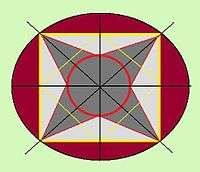Fort Carré
- See Stade du Fort Carré for the sports stadium.
| Fort Carré | |
|---|---|
| Antibes, France | |
 Fort Carré viewed from the south | |
 Vauban's architectural design | |
 Fort Carré | |
| Coordinates | 43°34′51″N 7°07′26″E / 43.580834°N 7.123889°E |
| Type | Fort |
| Site information | |
| Owner | Museum |
| Controlled by | France |
| Open to the public | Special occasions |
| Site history | |
| Built | 1553 |
Fort Carré, often Fort Carré d'Antibes, is a 16th-century star-shaped fort of four arrow-head shaped bastions, that stands on the outskirts of Antibes, France. Henri de Mandon built the fort and then during the 17th century, the Marquis de Vauban redeveloped it.
History
The Romans probably built the first fortifications at Antibes. In 1553, a tower called la tour Saint-Florent was built around a preexisting chapel. Henry III had four bastions added in 1565, whereupon it became Fort Carré (the squared fort).
In the 1680s, Vauban strengthened Fort Carré, adding traverses to protect against ricochet fire and exchanging the stone parapets, which were liable to scatter deadly splinters when hit by shot, for brick ones.[1] Vauban also enlarged the embrasures and added outer walls to the fortification.
Later, the fort's design was modified to take eighteen cannon. The entrance to the fort is through a triangular work that protrudes from the walls, and which is loopholed and pierced by a heavy wooden door. From here, there is a narrow bridge that leads into the fort itself via the flank of one of the arrow-headed bastions. Inside, there are barrack buildings for officers and men as well as the ancient chapel, which has been preserved through the successive stages of military development of the site.[1]
In addition to improving the defences of Fort Carré, Vauban fortified Antibes itself, adding a land front of four arrow-headed bastions around the town, as well as seaward fortifications, including a bastion on the breakwater closing the harbor.[1]
During the French Revolution, Napoleon Bonaparte was briefly imprisoned here. In July 1794, after the violent overthrow of Robespierre, General Bonaparte was detained as a Jacobin sympathizer and held in Fort Carré for ten days. His friend and political ally, Antoine Christophe Saliceti, secured his release.[2]
Then in 1860, the fort played an important role when France annexed Nice.
 Harbor view
Harbor view Metropolitan view
Metropolitan view Courtyard, east side
Courtyard, east side Southern point
Southern point
In popular culture
Fort Carré was used as the villain's fortress in the James Bond film, Never Say Never Again (1983).[3]
References
- 1 2 3 "Fort Carré, Antibes". Fortified Places. 2011. Retrieved 21 September 2011.
- ↑ Conner, Susan (30 March 2004). The Age of Napoleon. Westport, CT: Greenwood Publ. Group. p. 12. ISBN 978-0-313-32014-9. Retrieved 21 September 2011.
- ↑ Reeves, Tony (2001). The Worldwide Guide to Movie Locations. Chicago: A Cappella. p. 134. ISBN 978-1-55652-432-5.